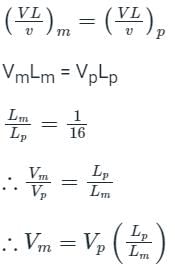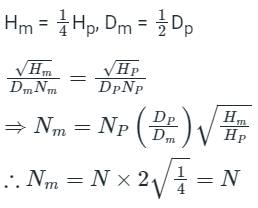Test: Reynolds model law - Civil Engineering (CE) MCQ
5 Questions MCQ Test - Test: Reynolds model law
A 1:16 scale model of a submarine moving far below the surface of water is tested in a water tunnel. If the speed of prototype is 8 m/s, the corresponding velocity of model in tunnel is ____
[Fluids are same in testing as in actual model]
[Fluids are same in testing as in actual model]
The non-dimensional number related to water hammer phenomenon is:
Water having kinematic viscosity of 0.01 stoke flows at a velocity of 2 m/s in a pipe of 15 cm diameter. For dynamic similarity, the velocity of oil of kinematic viscosity of 0.03 stoke in a pipe of same diameter will be
A model of a hydraulic turbine is tested at a head of 1/4th of that under which the full scale turbine works. The diameter of the model is half of that of the full scale turbine, if N is the RPM of the full scale turbine, then RPM of the model will be


















